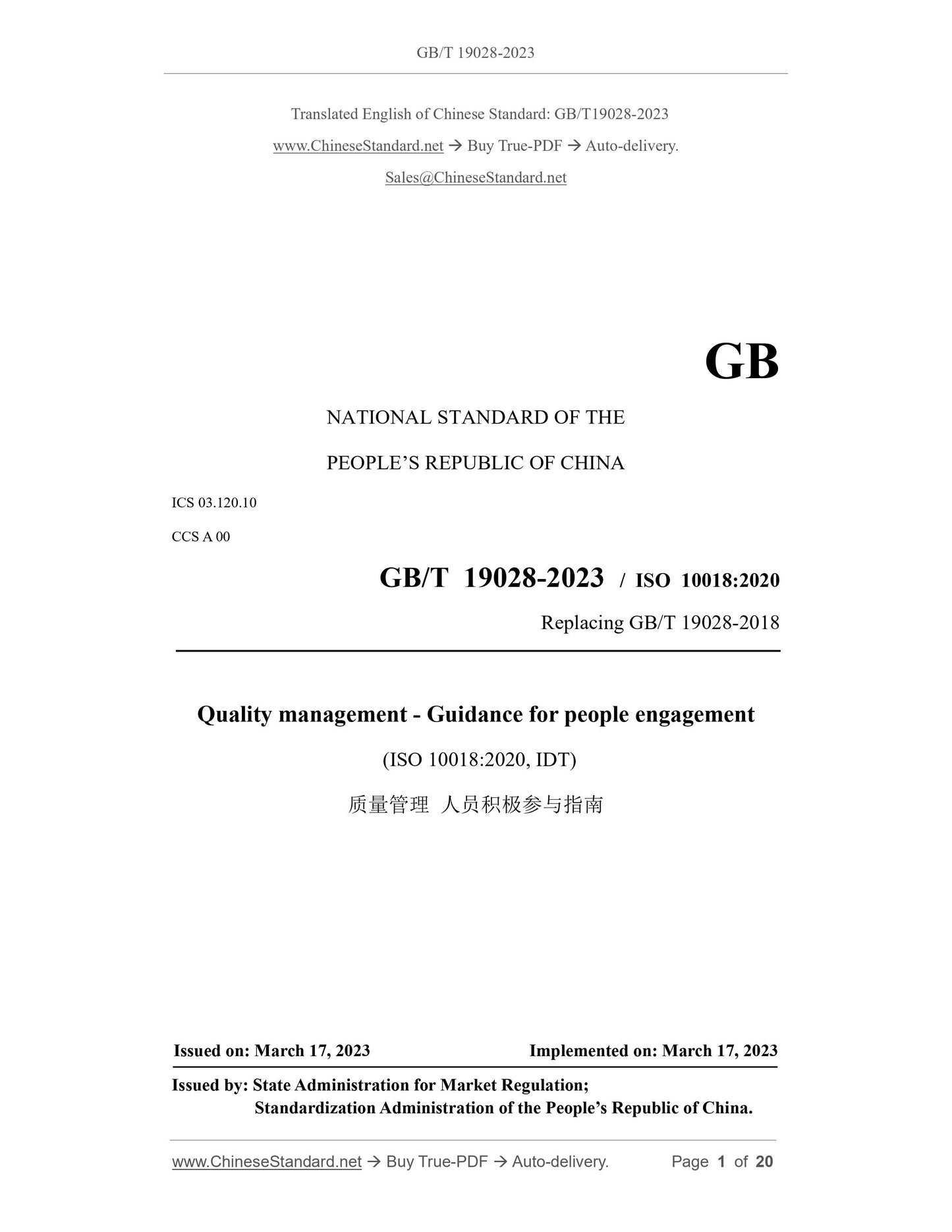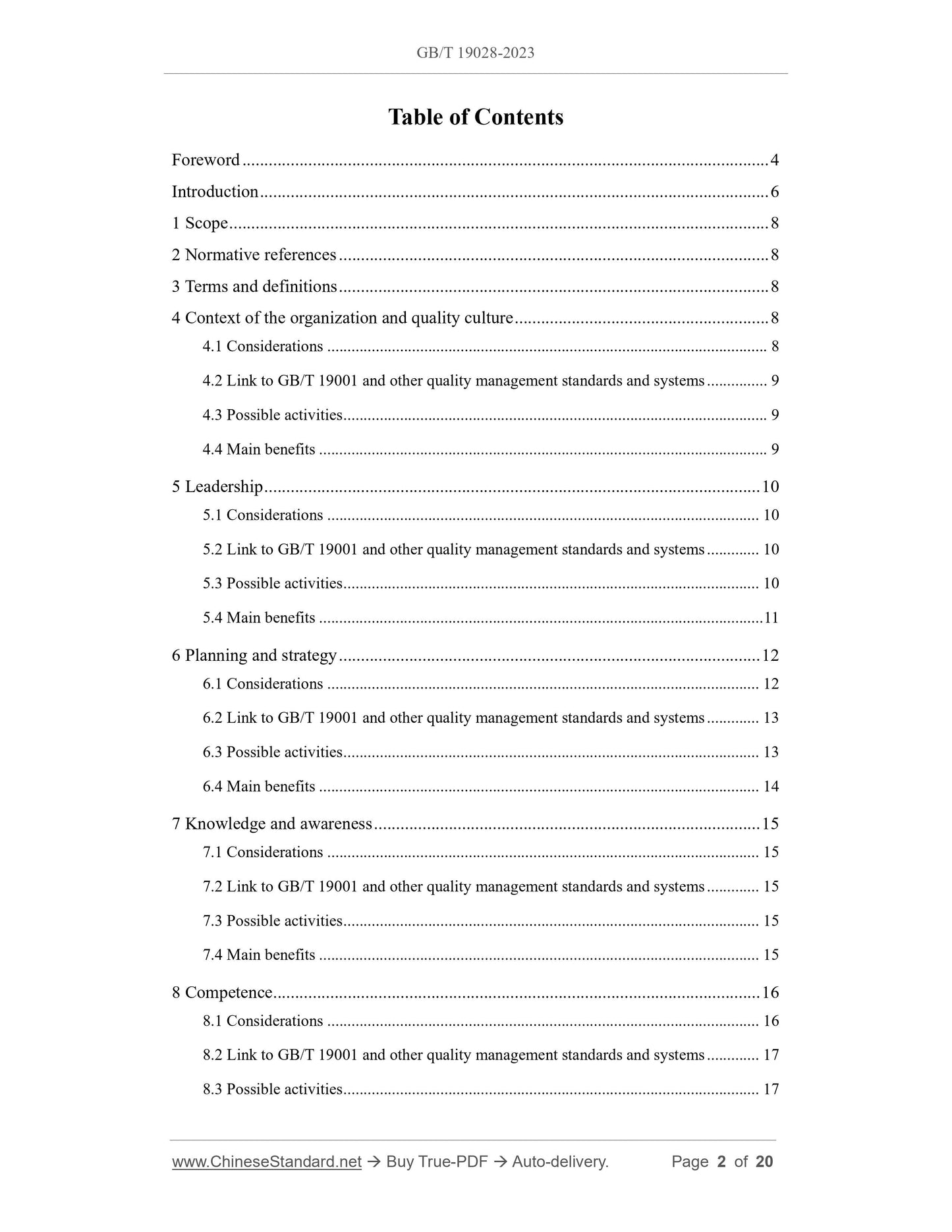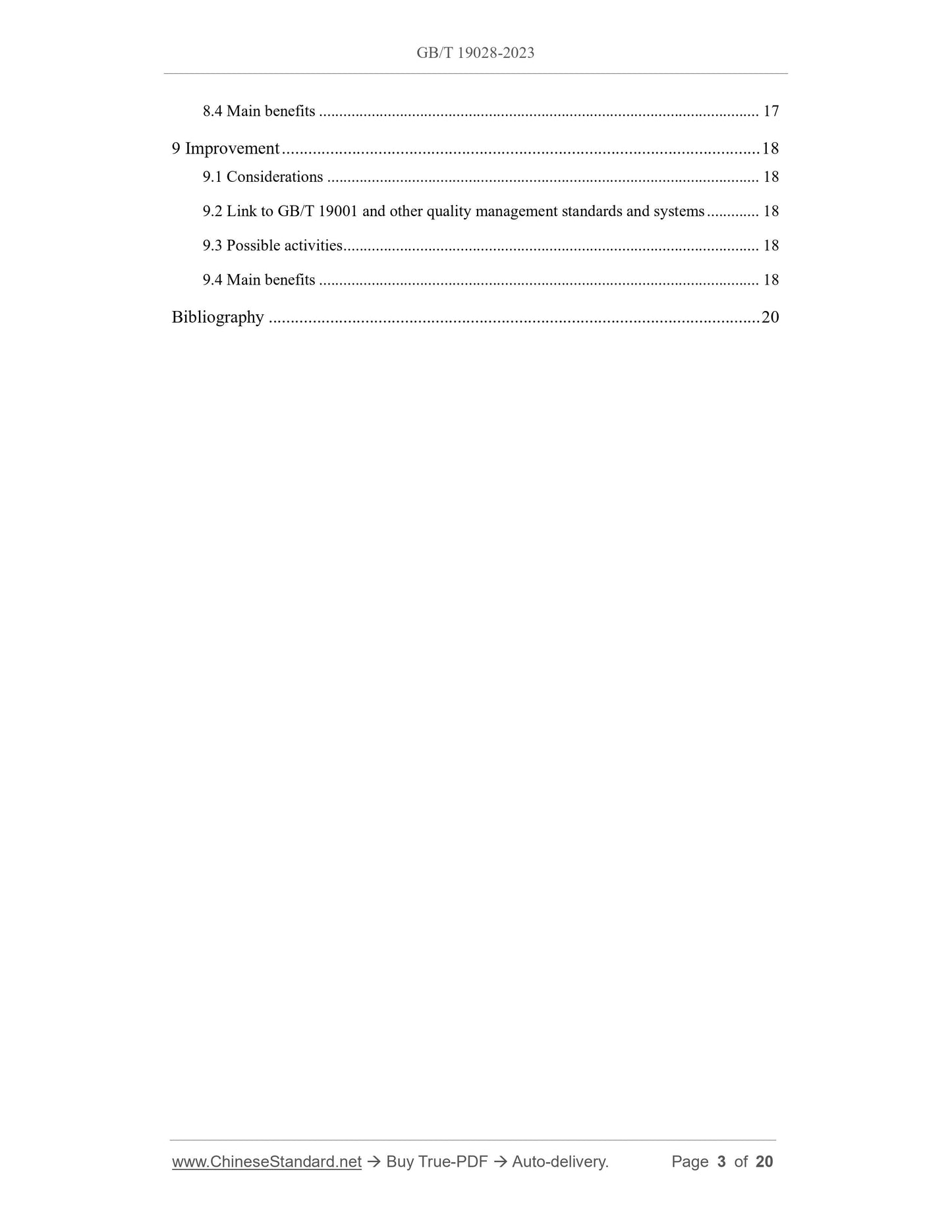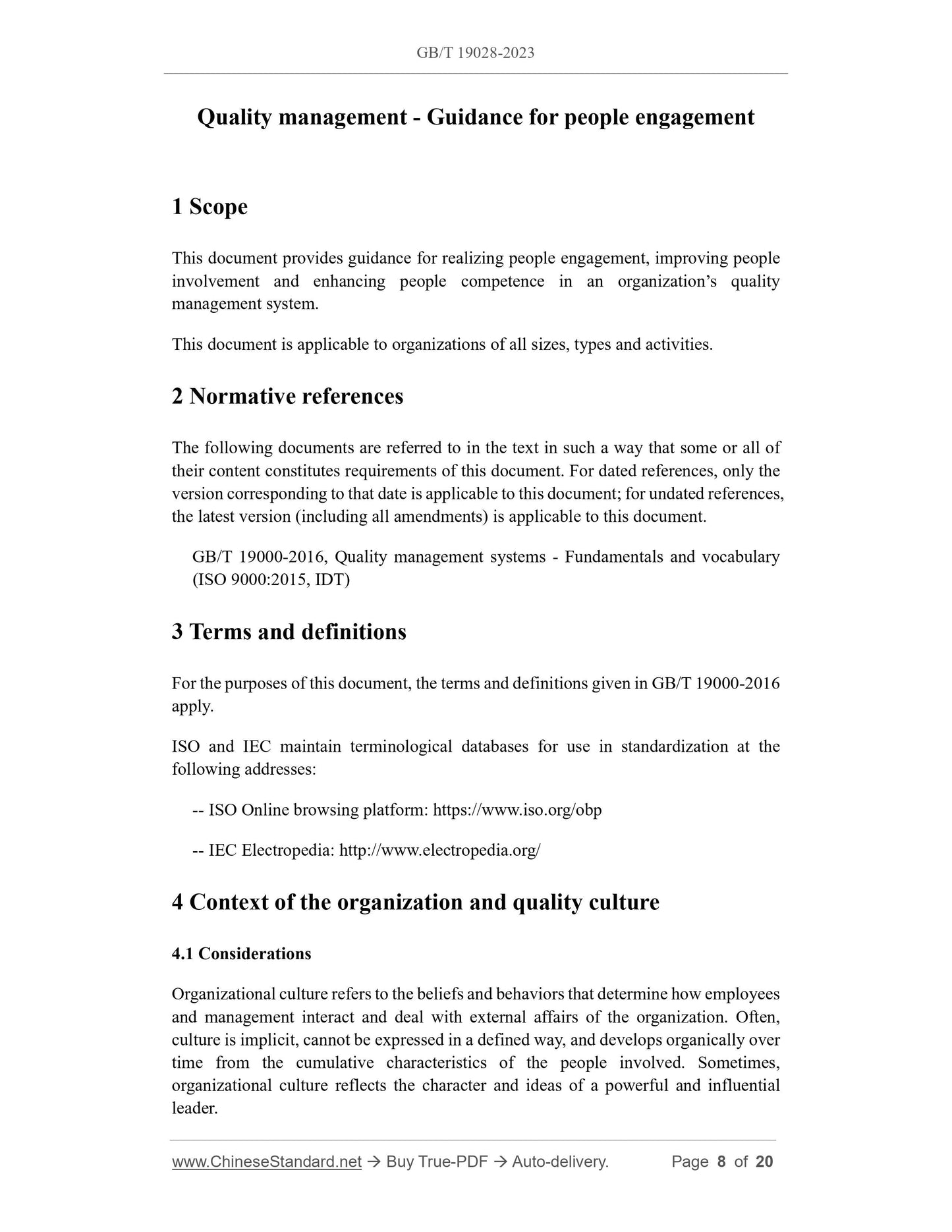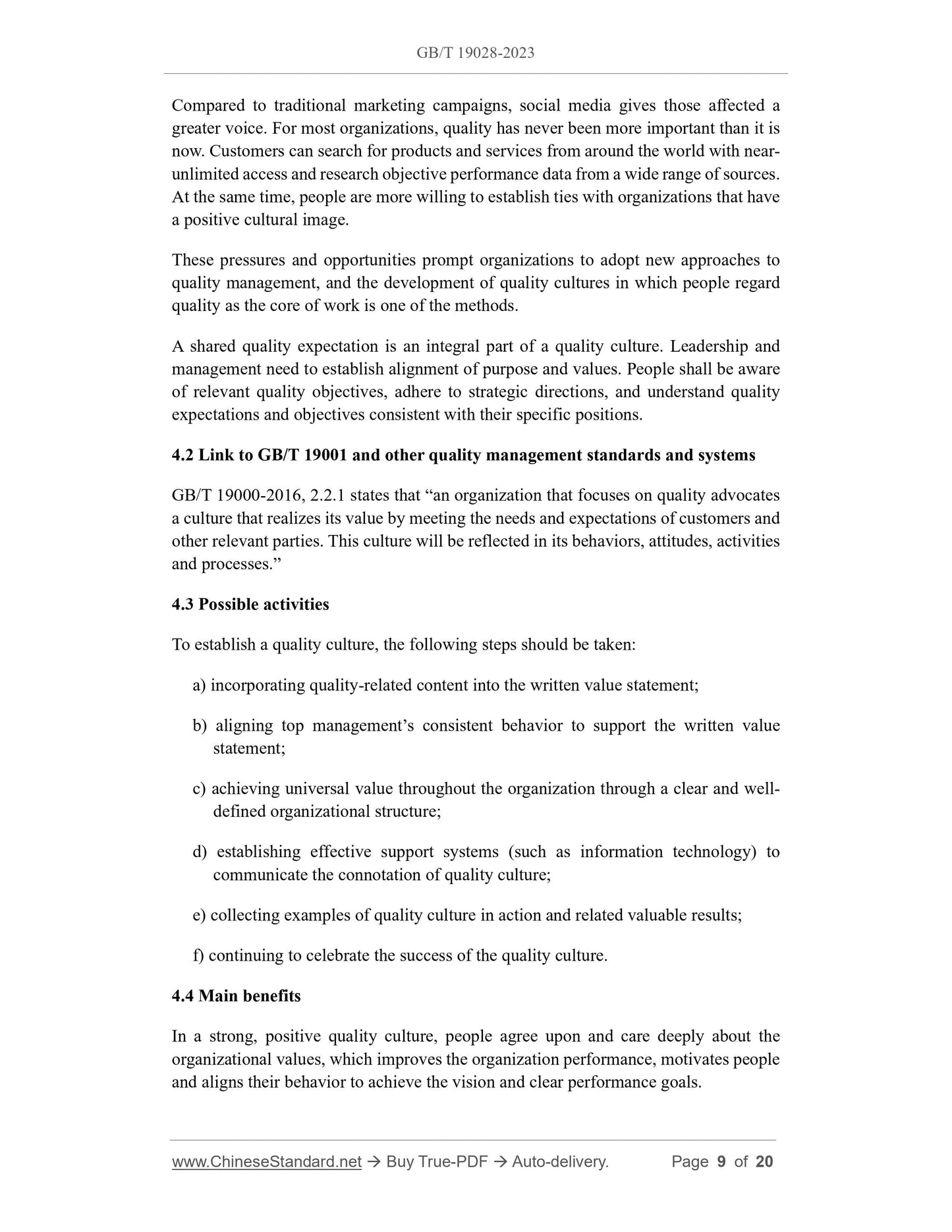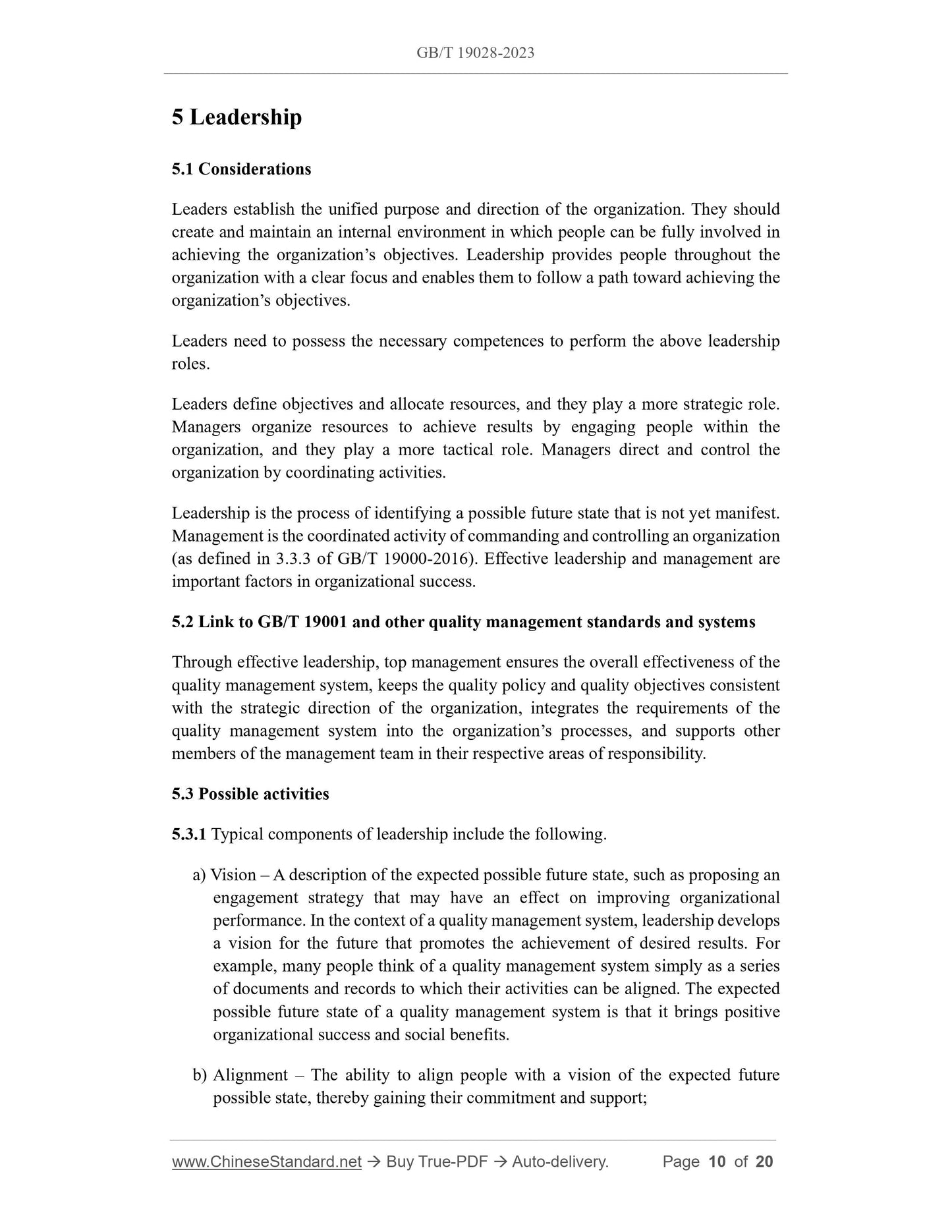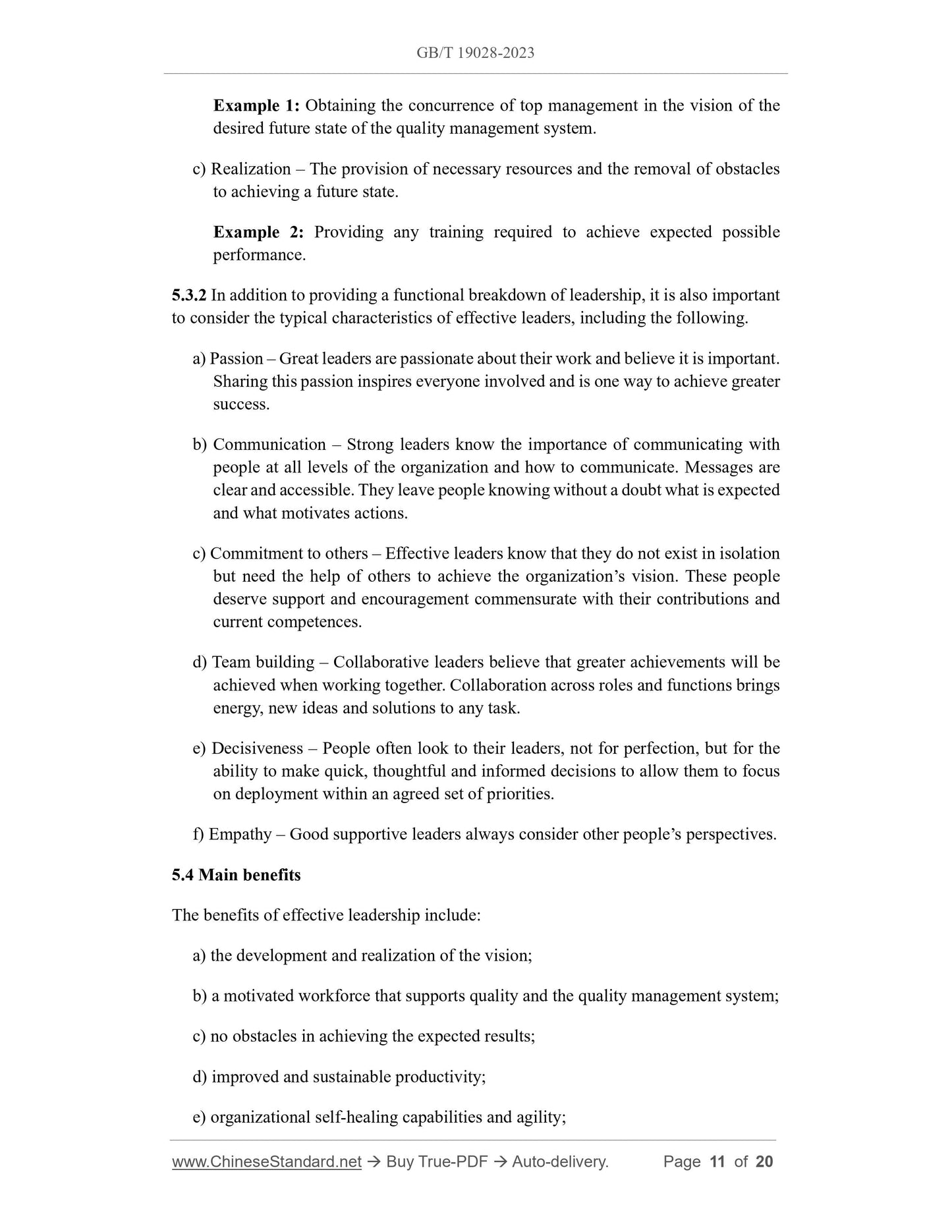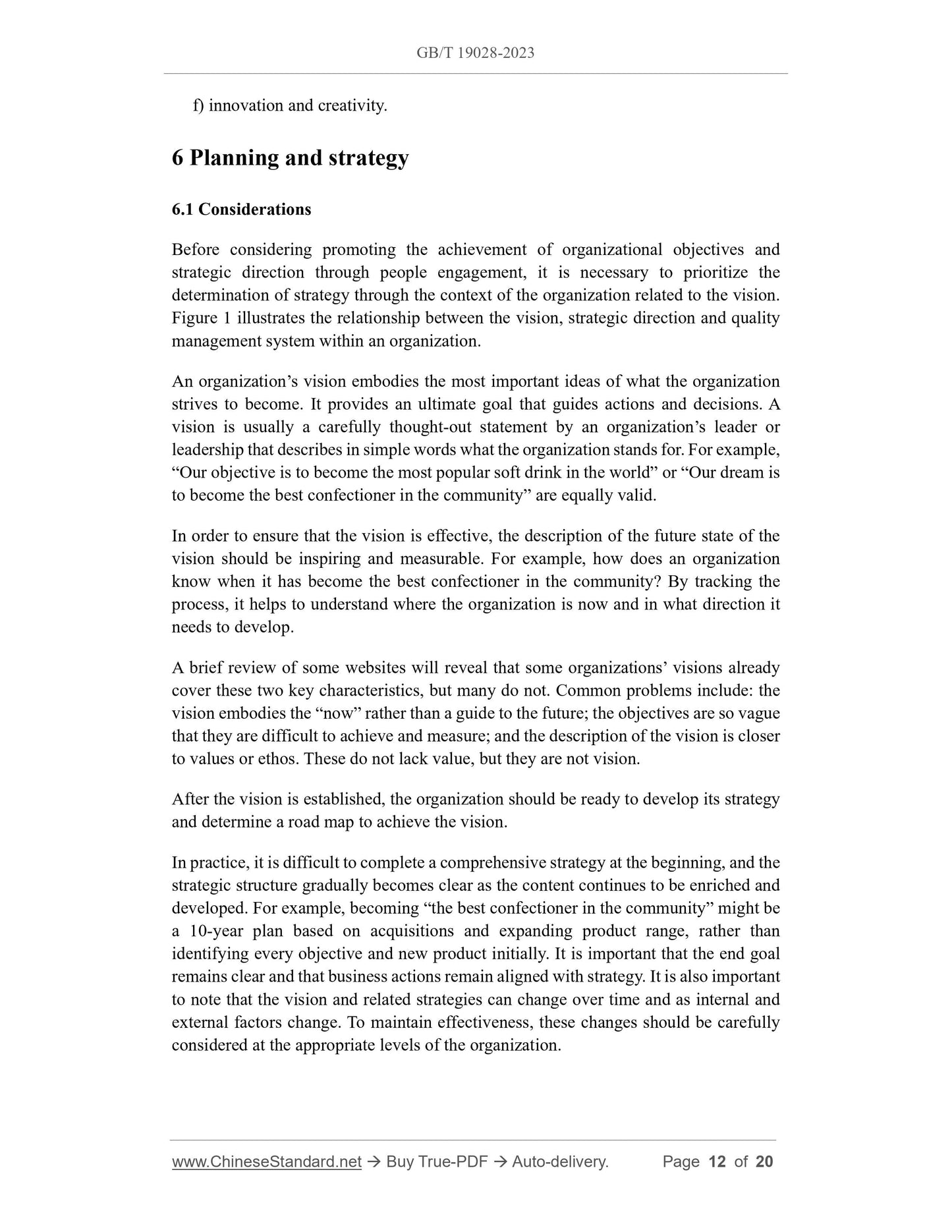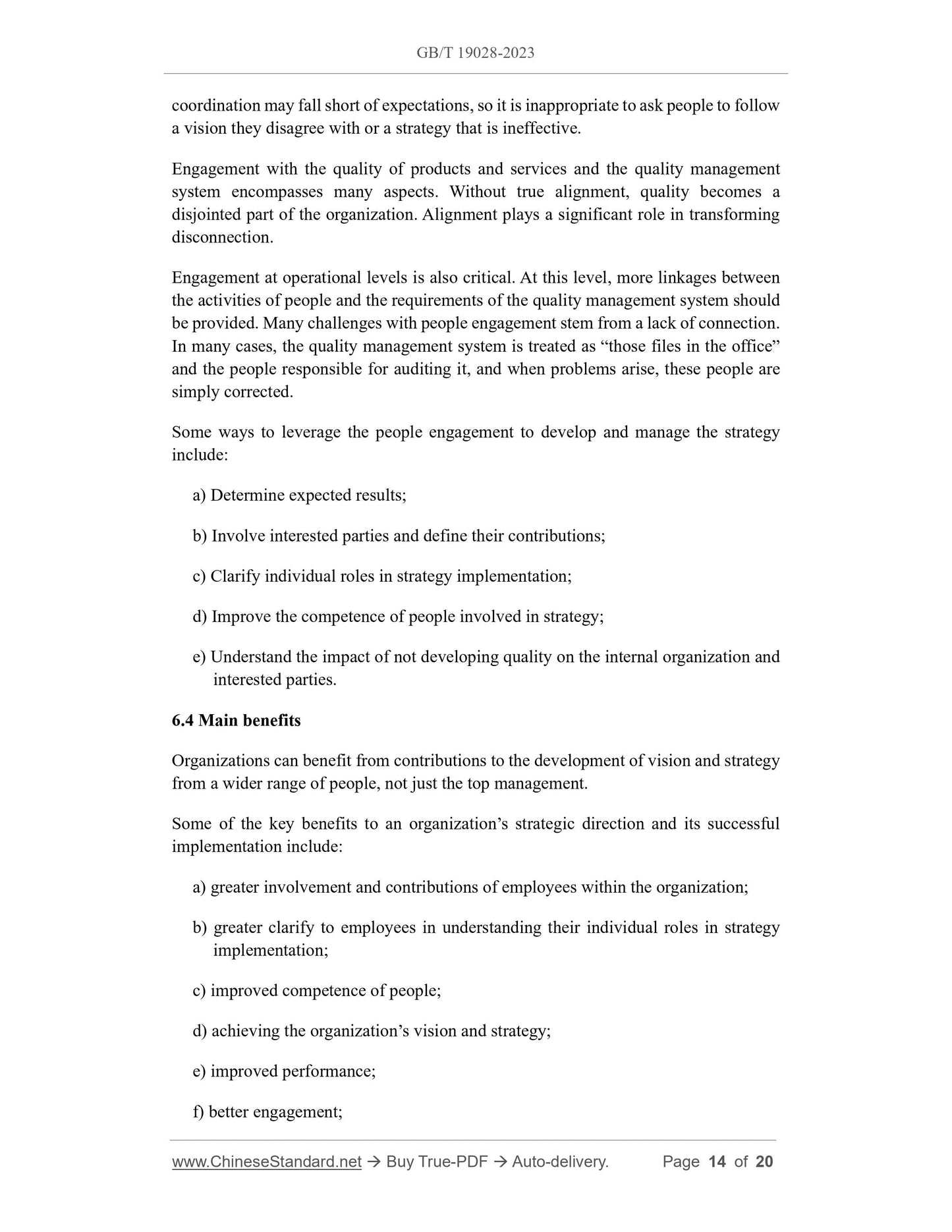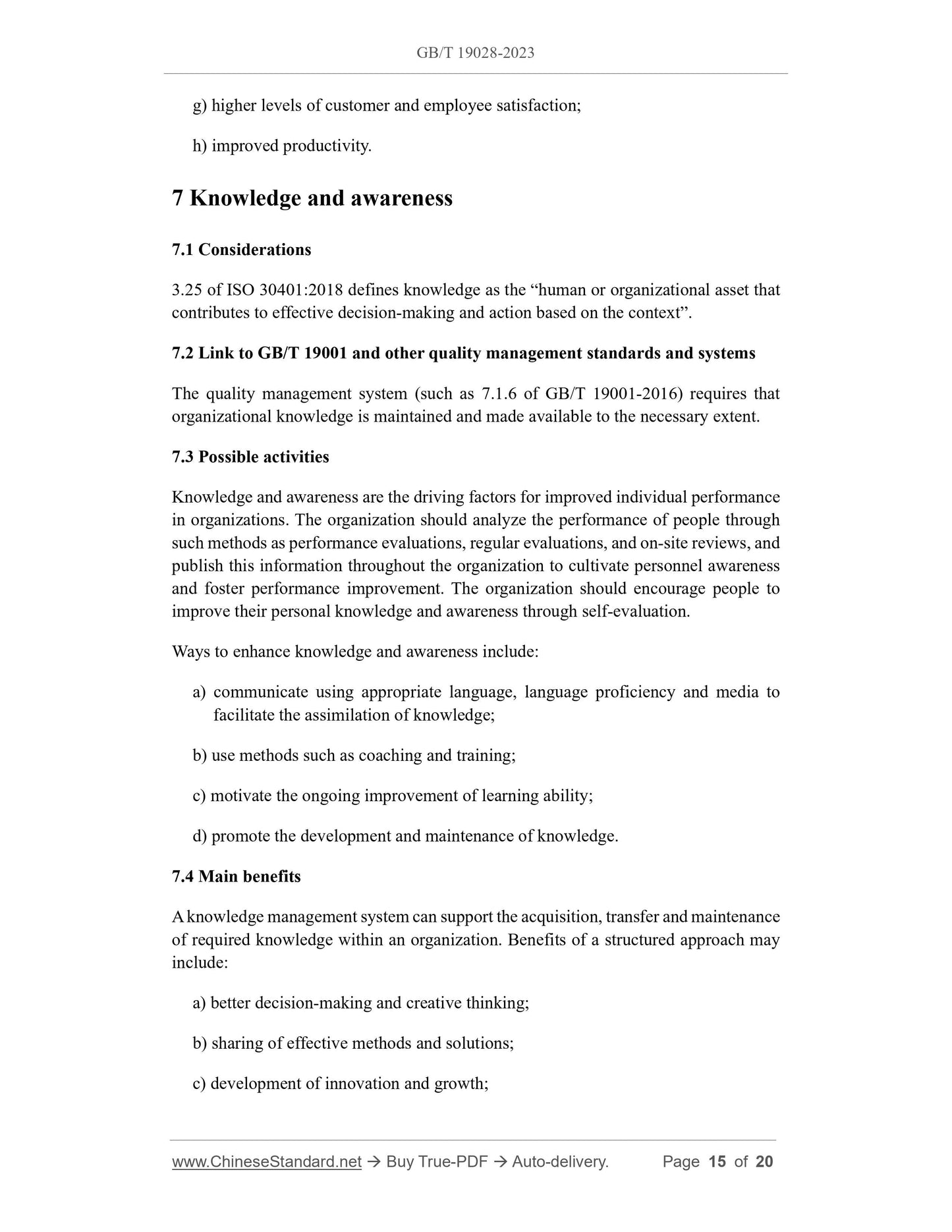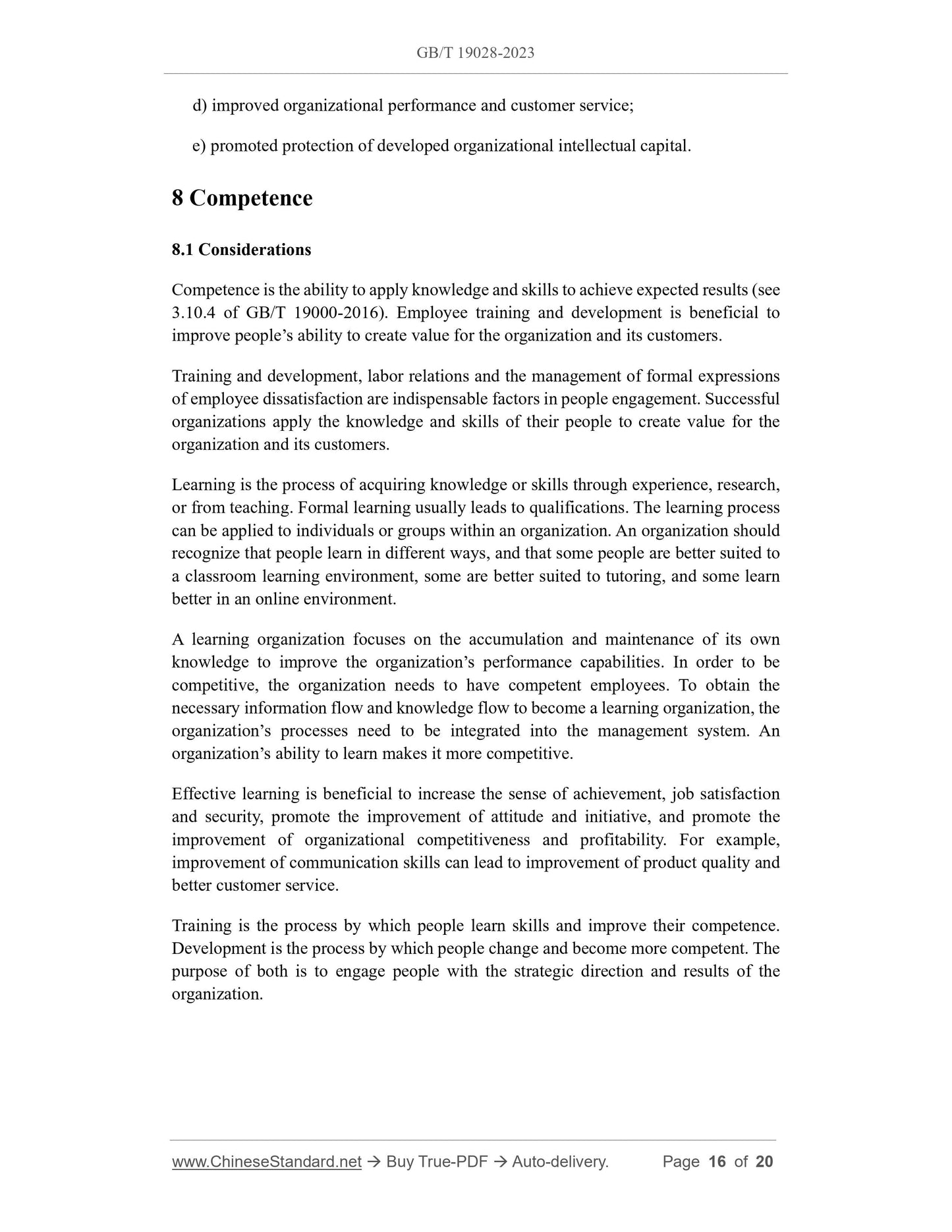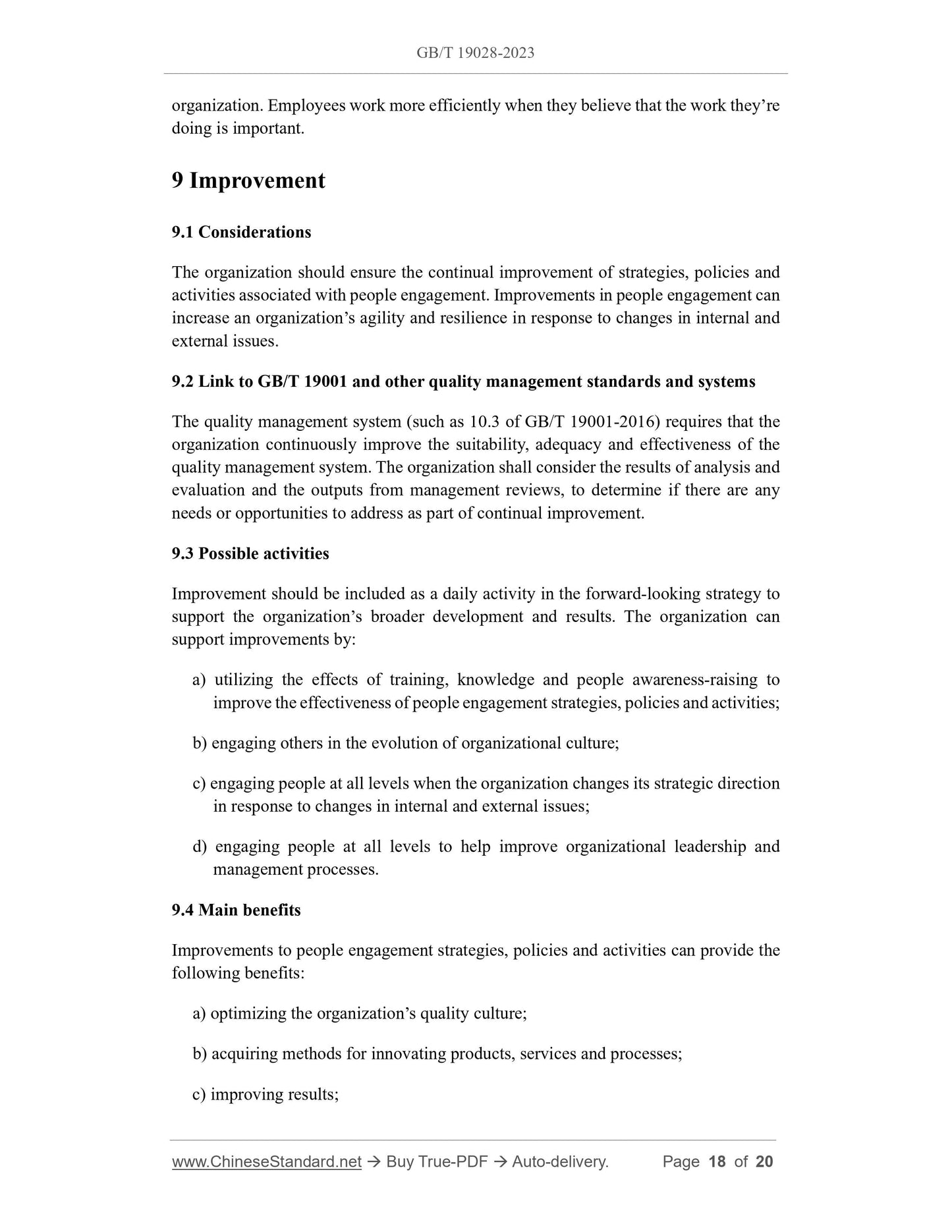1
/
of
12
PayPal, credit cards. Download editable-PDF and invoice in 1 second!
GB/T 19028-2023 English PDF (GBT19028-2023)
GB/T 19028-2023 English PDF (GBT19028-2023)
Regular price
$260.00 USD
Regular price
Sale price
$260.00 USD
Unit price
/
per
Shipping calculated at checkout.
Couldn't load pickup availability
Delivery: 3 seconds. Download true-PDF + Invoice.
Get QUOTATION in 1-minute: Click GB/T 19028-2023
Historical versions: GB/T 19028-2023
Preview True-PDF (Reload/Scroll if blank)
GB/T 19028-2023: Quality management -- Guidance for people engagement
GB/T 19028-2023
GB
NATIONAL STANDARD OF THE
PEOPLE’S REPUBLIC OF CHINA
ICS 03.120.10
CCS A 00
GB/T 19028-2023 / ISO 10018:2020
Replacing GB/T 19028-2018
Quality management - Guidance for people engagement
(ISO 10018:2020, IDT)
ISSUED ON: MARCH 17, 2023
IMPLEMENTED ON: MARCH 17, 2023
Issued by: State Administration for Market Regulation;
Standardization Administration of the People’s Republic of China.
Table of Contents
Foreword ... 4
Introduction ... 6
1 Scope ... 8
2 Normative references ... 8
3 Terms and definitions ... 8
4 Context of the organization and quality culture ... 8
4.1 Considerations ... 8
4.2 Link to GB/T 19001 and other quality management standards and systems ... 9
4.3 Possible activities ... 9
4.4 Main benefits ... 9
5 Leadership ... 10
5.1 Considerations ... 10
5.2 Link to GB/T 19001 and other quality management standards and systems ... 10
5.3 Possible activities ... 10
5.4 Main benefits ... 11
6 Planning and strategy ... 12
6.1 Considerations ... 12
6.2 Link to GB/T 19001 and other quality management standards and systems ... 13
6.3 Possible activities ... 13
6.4 Main benefits ... 14
7 Knowledge and awareness ... 15
7.1 Considerations ... 15
7.2 Link to GB/T 19001 and other quality management standards and systems ... 15
7.3 Possible activities ... 15
7.4 Main benefits ... 15
8 Competence ... 16
8.1 Considerations ... 16
8.2 Link to GB/T 19001 and other quality management standards and systems ... 17
8.3 Possible activities ... 17
8.4 Main benefits ... 17
9 Improvement ... 18
9.1 Considerations ... 18
9.2 Link to GB/T 19001 and other quality management standards and systems ... 18
9.3 Possible activities ... 18
9.4 Main benefits ... 18
Bibliography ... 20
Quality management - Guidance for people engagement
1 Scope
This document provides guidance for realizing people engagement, improving people
involvement and enhancing people competence in an organization’s quality
management system.
This document is applicable to organizations of all sizes, types and activities.
2 Normative references
The following documents are referred to in the text in such a way that some or all of
their content constitutes requirements of this document. For dated references, only the
version corresponding to that date is applicable to this document; for undated references,
the latest version (including all amendments) is applicable to this document.
GB/T 19000-2016, Quality management systems - Fundamentals and vocabulary
(ISO 9000:2015, IDT)
3 Terms and definitions
For the purposes of this document, the terms and definitions given in GB/T 19000-2016
apply.
ISO and IEC maintain terminological databases for use in standardization at the
following addresses:
-- ISO Online browsing platform: https://www.iso.org/obp
-- IEC Electropedia: http://www.electropedia.org/
4 Context of the organization and quality culture
4.1 Considerations
Organizational culture refers to the beliefs and behaviors that determine how employees
and management interact and deal with external affairs of the organization. Often,
culture is implicit, cannot be expressed in a defined way, and develops organically over
time from the cumulative characteristics of the people involved. Sometimes,
organizational culture reflects the character and ideas of a powerful and influential
leader.
Compared to traditional marketing campaigns, social media gives those affected a
greater voice. For most organizations, quality has never been more important than it is
now. Customers can search for products and services from around the world with near-
unlimited access and research objective performance data from a wide range of sources.
At the same time, people are more willing to establish ties with organizations that have
a positive cultural image.
These pressures and opportunities prompt organizations to adopt new approaches to
quality management, and the development of quality cultures in which people regard
quality as the core of work is one of the methods.
A shared quality expectation is an integral part of a quality culture. Leadership and
management need to establish alignment of purpose and values. People shall be aware
of relevant quality objectives, adhere to strategic directions, and understand quality
expectations and objectives consistent with their specific positions.
4.2 Link to GB/T 19001 and other quality management standards and systems
GB/T 19000-2016, 2.2.1 states that “an organization that focuses on quality advocates
a culture that realizes its value by meeting the needs and expectations of customers and
other relevant parties. This culture will be reflected in its behaviors, attitudes, activities
and processes.”
4.3 Possible activities
To establish a quality culture, the following steps should be taken:
a) incorporating quality-related content into the written value statement;
b) aligning top management’s consistent behavior to support the written value
statement;
c) achieving universal value throughout the organization through a clear and well-
defined organizational structure;
d) establishing effective support systems (such as information technology) to
communicate the connotation of quality culture;
e) collecting examples of quality culture in action and related valuable results;
f) continuing to celebrate the success of the quality culture.
4.4 Main benefits
In a strong, positive quality culture, people agree upon and care deeply about the
organizational values, which improves the organization performance, motivates people
and aligns their behavior to achieve the vision and clear performance goals.
5 Leadership
5.1 Considerations
Leaders establish the unified purpose and direction of the organization. They should
create and maintain an internal environment in which people can be fully involved in
achieving the organization’s objectives. Leadership provides people throughout the
organization with a clear focus and enables them to follow a path toward achieving the
organization’s objectives.
Leaders need to possess the necessary competences to perform the above leadership
roles.
Leaders define objectives and allocate resources, and they play a more strategic role.
Managers organize resources to achieve results by engaging people within the
organization, and they play a more tactical role. Managers direct and control the
organization by coordinating activities.
Leadership is the process of identifying a possible future state that is not yet manifest.
Management is the coordinated activity of commanding and controlling an organization
(as defined in 3.3.3 of GB/T 19000-2016). Effective leadership and management are
important factors in organizational success.
5.2 Link to GB/T 19001 and other quality management standards and systems
Through effective leadership, top management ensures the overall effectiveness of the
quality management system, keeps the quality policy and quality objectives consistent
with the strategic direction of the organization, integrates the requirements of the
quality management system into the organization’s processes, and supports other
members of the management team in their respective areas of responsibility.
5.3 Possible activities
5.3.1 Typical components of leadership include the following.
a) Vision – A description of the expected possible future state, such as proposing an
...
Get QUOTATION in 1-minute: Click GB/T 19028-2023
Historical versions: GB/T 19028-2023
Preview True-PDF (Reload/Scroll if blank)
GB/T 19028-2023: Quality management -- Guidance for people engagement
GB/T 19028-2023
GB
NATIONAL STANDARD OF THE
PEOPLE’S REPUBLIC OF CHINA
ICS 03.120.10
CCS A 00
GB/T 19028-2023 / ISO 10018:2020
Replacing GB/T 19028-2018
Quality management - Guidance for people engagement
(ISO 10018:2020, IDT)
ISSUED ON: MARCH 17, 2023
IMPLEMENTED ON: MARCH 17, 2023
Issued by: State Administration for Market Regulation;
Standardization Administration of the People’s Republic of China.
Table of Contents
Foreword ... 4
Introduction ... 6
1 Scope ... 8
2 Normative references ... 8
3 Terms and definitions ... 8
4 Context of the organization and quality culture ... 8
4.1 Considerations ... 8
4.2 Link to GB/T 19001 and other quality management standards and systems ... 9
4.3 Possible activities ... 9
4.4 Main benefits ... 9
5 Leadership ... 10
5.1 Considerations ... 10
5.2 Link to GB/T 19001 and other quality management standards and systems ... 10
5.3 Possible activities ... 10
5.4 Main benefits ... 11
6 Planning and strategy ... 12
6.1 Considerations ... 12
6.2 Link to GB/T 19001 and other quality management standards and systems ... 13
6.3 Possible activities ... 13
6.4 Main benefits ... 14
7 Knowledge and awareness ... 15
7.1 Considerations ... 15
7.2 Link to GB/T 19001 and other quality management standards and systems ... 15
7.3 Possible activities ... 15
7.4 Main benefits ... 15
8 Competence ... 16
8.1 Considerations ... 16
8.2 Link to GB/T 19001 and other quality management standards and systems ... 17
8.3 Possible activities ... 17
8.4 Main benefits ... 17
9 Improvement ... 18
9.1 Considerations ... 18
9.2 Link to GB/T 19001 and other quality management standards and systems ... 18
9.3 Possible activities ... 18
9.4 Main benefits ... 18
Bibliography ... 20
Quality management - Guidance for people engagement
1 Scope
This document provides guidance for realizing people engagement, improving people
involvement and enhancing people competence in an organization’s quality
management system.
This document is applicable to organizations of all sizes, types and activities.
2 Normative references
The following documents are referred to in the text in such a way that some or all of
their content constitutes requirements of this document. For dated references, only the
version corresponding to that date is applicable to this document; for undated references,
the latest version (including all amendments) is applicable to this document.
GB/T 19000-2016, Quality management systems - Fundamentals and vocabulary
(ISO 9000:2015, IDT)
3 Terms and definitions
For the purposes of this document, the terms and definitions given in GB/T 19000-2016
apply.
ISO and IEC maintain terminological databases for use in standardization at the
following addresses:
-- ISO Online browsing platform: https://www.iso.org/obp
-- IEC Electropedia: http://www.electropedia.org/
4 Context of the organization and quality culture
4.1 Considerations
Organizational culture refers to the beliefs and behaviors that determine how employees
and management interact and deal with external affairs of the organization. Often,
culture is implicit, cannot be expressed in a defined way, and develops organically over
time from the cumulative characteristics of the people involved. Sometimes,
organizational culture reflects the character and ideas of a powerful and influential
leader.
Compared to traditional marketing campaigns, social media gives those affected a
greater voice. For most organizations, quality has never been more important than it is
now. Customers can search for products and services from around the world with near-
unlimited access and research objective performance data from a wide range of sources.
At the same time, people are more willing to establish ties with organizations that have
a positive cultural image.
These pressures and opportunities prompt organizations to adopt new approaches to
quality management, and the development of quality cultures in which people regard
quality as the core of work is one of the methods.
A shared quality expectation is an integral part of a quality culture. Leadership and
management need to establish alignment of purpose and values. People shall be aware
of relevant quality objectives, adhere to strategic directions, and understand quality
expectations and objectives consistent with their specific positions.
4.2 Link to GB/T 19001 and other quality management standards and systems
GB/T 19000-2016, 2.2.1 states that “an organization that focuses on quality advocates
a culture that realizes its value by meeting the needs and expectations of customers and
other relevant parties. This culture will be reflected in its behaviors, attitudes, activities
and processes.”
4.3 Possible activities
To establish a quality culture, the following steps should be taken:
a) incorporating quality-related content into the written value statement;
b) aligning top management’s consistent behavior to support the written value
statement;
c) achieving universal value throughout the organization through a clear and well-
defined organizational structure;
d) establishing effective support systems (such as information technology) to
communicate the connotation of quality culture;
e) collecting examples of quality culture in action and related valuable results;
f) continuing to celebrate the success of the quality culture.
4.4 Main benefits
In a strong, positive quality culture, people agree upon and care deeply about the
organizational values, which improves the organization performance, motivates people
and aligns their behavior to achieve the vision and clear performance goals.
5 Leadership
5.1 Considerations
Leaders establish the unified purpose and direction of the organization. They should
create and maintain an internal environment in which people can be fully involved in
achieving the organization’s objectives. Leadership provides people throughout the
organization with a clear focus and enables them to follow a path toward achieving the
organization’s objectives.
Leaders need to possess the necessary competences to perform the above leadership
roles.
Leaders define objectives and allocate resources, and they play a more strategic role.
Managers organize resources to achieve results by engaging people within the
organization, and they play a more tactical role. Managers direct and control the
organization by coordinating activities.
Leadership is the process of identifying a possible future state that is not yet manifest.
Management is the coordinated activity of commanding and controlling an organization
(as defined in 3.3.3 of GB/T 19000-2016). Effective leadership and management are
important factors in organizational success.
5.2 Link to GB/T 19001 and other quality management standards and systems
Through effective leadership, top management ensures the overall effectiveness of the
quality management system, keeps the quality policy and quality objectives consistent
with the strategic direction of the organization, integrates the requirements of the
quality management system into the organization’s processes, and supports other
members of the management team in their respective areas of responsibility.
5.3 Possible activities
5.3.1 Typical components of leadership include the following.
a) Vision – A description of the expected possible future state, such as proposing an
...
Share
